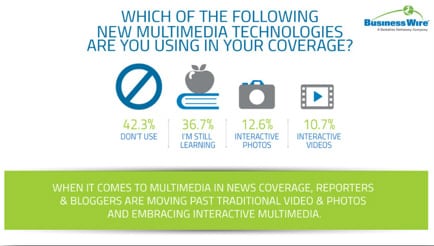
The age of interactive multimedia is upon us. With images that can be clicked and investigated—the media showing up on digital platforms begs for extended user engagement. The user, more often than not, complies. Why are interactive assets enthralling audiences for as much as 10 minutes? How can you, a communications or marketing professional, harness this kind of engagement for your own use?
The use of images, videos, and other multimedia is quickly becoming standard practice in news content and other journalistic media. It is the ability to make multimedia interactive that breaks the fourth wall and invites the viewer to become a part of the journalistic process of information discovery.
From the development of Facebook video following the success of YouTube videos on Facebook’s social media platform, to Twitter partnering with Photobucket for image sharing capabilities and later launching Periscope, images and videos became an integral part of the digital experience. Just like the internet evolved into web 2.0, interactive multimedia is a natural progression of static media. It takes multimedia and reengineers it to better reach and activate audiences. Why? Because interactive assets are simply more engaging to the viewer.
The success of multimedia and especially interactive multimedia can be explained using scientific evidence. According to Business Wire’s 2015 report Let’s Get Visual: Multimedia and the News Release, humans process images 60,000 times faster than plain text. That means the information presented in an image gets absorbed and analyzed quicker, shortening the time needed to understand the intended message. There is also a benefit in using color multimedia. According to the report:
Color images have a stronger effect on the viewer than ones that are black and white. The striking vibrancy of color triggers a reaction in people resulting in longer multimedia viewing time. Color advertisements have been shown to retain 42% more attention when compared to their grayscale equivalent. If the goal of a news release is garnering attention, then the best practice is grabbing the reader with a vibrant, full color image.
 According to a study by Richard E. Mayer and Roxana Moreno, there is a distinct “multimedia effect.” The result of their styles-of-learning research demonstrates that 65% of people are visual learners.
According to a study by Richard E. Mayer and Roxana Moreno, there is a distinct “multimedia effect.” The result of their styles-of-learning research demonstrates that 65% of people are visual learners.
Students who read a text containing captioned illustrations placed near the corresponding words generated about 65% more useful solutions on a subsequent problem-solving transfer test than did students who simply read the text (Mayer, 1989; Mayer & Gallini, 1990).
Journalists, reporters, and other media professionals might not know the science behind the effective qualities of multimedia, but they see the results in their own content. It’s near impossible to find news today without multimedia. Images and videos supplementing news stories is no longer a trend but a standard practice. When journalists research news releases for breaking stories, those containing multimedia assets are a welcome sight. So much so that they are outspoken about their use of those very releases.
According to Business Wire’s 2015 Media Survey, over 50% of responding journalists say they would be likely to use a news release if it included some form of multimedia element. That means about one out of every two reporters, bloggers, or other media professionals is using a news release as a result of multimedia. Interactive multimedia is the next step in the evolution of media—it is multimedia 2.0.
The difference between yesterday’s multimedia, static images and videos, and the interactive multimedia making a splash over today’s content is the audience’s ability to investigate. Interactive multimedia such as this map featured on National Geographic’s website allows the user to scroll the world, revealing more information with every click.
Instead of all of the information about changing water levels being presented in one graphic, a series of graphics are presented allowing the viewer to see greater detail in each and discover the individual facts they want to learn. This use of information discovery is ideal for news content purposes. That is why it is not surprising to learn that interactive multimedia assets such as Business Wire’s news and picture capsules, containing images, videos, and text, average more than 6 minutes of engagement per viewer. An outrageously high amount of time, but in reality, the viewer is consuming so much news information they don’t even notice they have stayed on one asset for this long.
This is evidence of the impact interactive assets have on how audiences respond to a news release. The extra time a viewer spends looking at a release creates the perfect opportunity for information absorption and brand awareness.
The growth of interactive images in the news industry is highlighted in the 2015 Business Wire Media Survey in which more than 23 percent of media noted interactive assets as a key media tool for the future of news. With this prediction, there is no better time than now for companies to embrace interactive assets.
Interactive multimedia is partially a product of developments in technology. With phones, televisions, and watches becoming smart overnight, people have 24/7 access to multimedia. The more capable technology becomes, the more the multimedia it carries will evolve. The ability to interact with an asset gives the viewer the ability to be more than just a viewer. It gives them the opportunity to control the process they take to learn the messaging being presented. Multimedia became interactive and will continue to be interactive. What audiences have to look forward to is just how interactive it will become.
Vilan Trub is a marketing copywriter at Business Wire. Follow them @BusinessWire.

